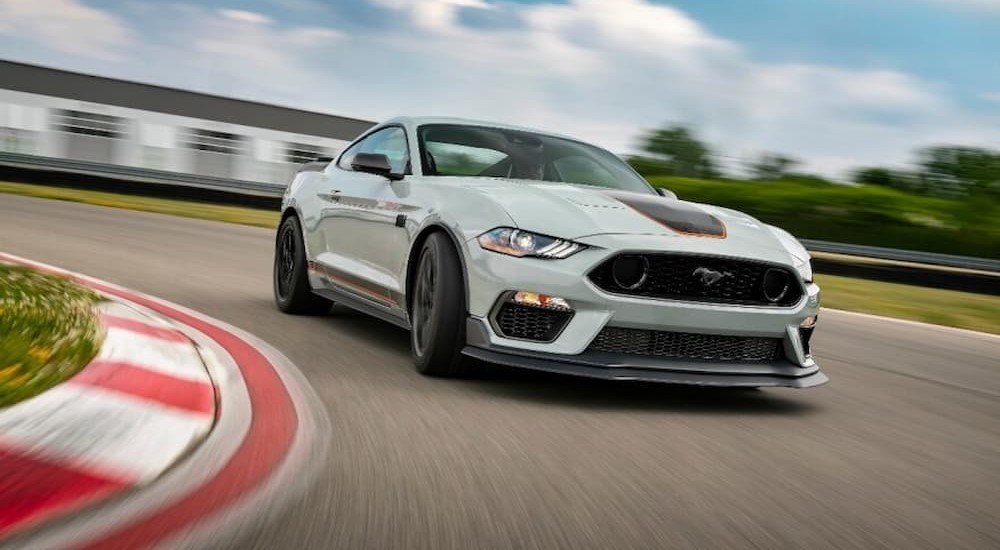When Henry Ford dreamed up the world’s first mass-produced car, he had three simple goals in mind: he wanted it to be easy to operate, durable, and (most importantly) affordable. For over 120 years, that formula has served the company well, allowing the automaker to grow into one of the industry’s largest while building a reputation for quality and reliability. That’s certainly an admirable approach, but what about those times when easy, durable, and affordable just won’t cut it? While Ford’s managed to produce some of the industry’s most iconic and best-selling vehicles, it’s the brand’s performance-oriented models that get a gearhead’s blood pumping.
From inventing the pony car category in the mid-1960s to unveiling one of the first street-legal super trucks in the 2000s, Ford is no stranger to the high-octane side of the driving lifestyle. Walk into your local Ford dealership and you’ll find Ford’s performance offerings are divided into a few distinct models and badges with the Mustang Mach 1, ST-branded cars and SUVs, and Raptor versions of the F-150, Ranger, and Bronco giving drivers something to get excited about. So how did these performance-minded vehicles come to be and how do they fit into the current Ford lineup? We’ll explore all that and more as we take a closer look at Ford’s performance models.
The Ford Mustang Mach 1
The Ford Mustang is already one of the world’s most iconic and best-selling sports cars, but the Mach 1 takes it to an entirely new level with the sort of performance that’ll have you itching for your next track day. When it was first released in 1964, the Mustang was such a genre-defying sensation that the industry soon had to coin a new term to classify the model’s many imitators. Representing a triple threat with its compact size, sporty design, and affordable price tag, the original pony car took the world by storm upon its debut, and the original Mach 1 wasn’t far behind.
Ford delivered the first Mach 1 version of the Mustang in 1969 and immediately grabbed headlines as it earned back-to-back SCCA Manufacturer’s Rally Championships in 1969 and 1970 and set an unbelievable 295 speed and endurance records at the Bonneville Salt Flats. This was made possible thanks to the model’s impressive lineup of engines, which ranged from 5.8L and 6.4L engines to a massive 7.0L Super Cobra Jet engine with an optional Ram Air intake that could hit 335 hp and 440 lb-ft of torque. The first Mach 1 also featured numerous sport styling cues: from a matte black hood treatment and scoop to a chrome gas cap, chrome exhaust tips, spoilers, and more. Shipped with an upgraded competition-level suspension, the Mach 1 gave the average driver the chance to experience the sort of high-speed thrills that are usually reserved for professional racing circuits.
Ford carried the Mach 1 name into the Mustang’s second generation starting in 1974 but discontinued the model in 1979 with the advent of the third-gen Mustang. Rising fuel prices and low sales contributed to the model’s demise, but the pony car wasn’t saying “goodbye,” just “until we meet again.” That reunion would come in 2003 when Ford rolled out a limited-run Mustang Mach 1. Available for two short years, the fourth-generation Mach 1 replaced the SVT Cobra as Ford’s sportiest Mustang. Featuring heavy-duty performance components such as Brembo front brake rotors, Tokico gas shocks and struts, and redesigned springs, the engine was the real star of the show. Ford dropped an all-aluminum, 4.6L Modular V8 engine under the hood, borrowing the intake camshafts from Lincoln’s InTech V8 to improve torque and allowing the revived Mach 1 to put out some 305 hp along with 320 lb-ft of torque–fast enough to speed from zero to 60 mph in just 5.2 seconds.
With Ford making some ambitious EV plans and phasing out most of its cars in favor of increasingly popular crossovers and SUVs, I thought I’d seen the end of the Mach 1. Thankfully, that proved to be incorrect as Ford rolled out the fifth-generation Mustang Mach 1 in 2021. Powered by the same 5.0L Coyote V8 found in the Mustang GT, the Mach 1 is the most powerful Mustang on record at 480 hp and 420 lb-ft of torque. Loaded with parts from the iconic Shelby Mustang, the modern Mach 1 features a race-ready intake manifold, engine oil cooler, rear axle cooling system, and rear diffuser. Ford’s MagneRide damping system can adjust the Mustang’s ride 1,000 times per second, while an engraved interior badge displays each model’s unique chassis number. Those looking for the most kitted-out Mach 1 on offer should spring for the Handling Package, which adds 19-inch dark-painted aluminum wheels, adjustable strut top mounts, a performance rear spoiler, and a front aero splitter.
The Ford Raptor Models
The Raptor is one of the newest additions to Ford’s performance-minded lineup and aims to do for the SUV and pickup segment what the Mach 1 badging has done for the Mustang. Specifically: pack it with as much power as humanly possible. Inspired by the sort of burly, off-road racing trophy trucks of the Baja 1000, the Raptor takes America’s best-selling pickup and transforms it into a no-holds-barred truck that still manages to be street-legal. The Raptor wasn’t Ford’s first experiment with souping up the F-150. That honor would go to the SVT Lightning in the 1990s, a low-riding version of the F-150 with a 5.4L V8 engine and overhauled suspension that was aimed at sporty performance.
Following the discontinuation of the SVT Lightning in 2004, Ford took another run at SVT-izing an F-150 in 2010 with the SVT Raptor. While the model shared the SVT Lightning’s 5.4L V8, it ditched the lowered suspension for a full suite of components that allowed it to excel in bumpy off-road terrain. From long-travel shocks and skid plates to all-terrain tires and more, the SVT Raptor was a force to be reckoned with in any off-road race. Case in point: Ford took an early concept version dubbed the SVT Raptor R out to the Mexican desert to enter the pickup in the grueling Baja 1000. With a custom 411-hp 6.2L V8 under the hood, the SVT Raptor R finished third in its class, announcing itself to the world.
The model took a two-year hiatus after 2014, but burst back onto the scene in 2017, dropping the SVT prefix and becoming the F-150 Raptor. Ford swapped the V8 for a high-output 3.5L EcoBoost V6 that delivers similar power without being quite as thirsty. A new 10-speed automatic transmission goes a long way in improving acceleration, while Ford’s Terrain Management system gives drivers the ability to customize their ride to fit specific road and trail conditions. The F-150 Raptor also dropped 500 lbs when compared to its predecessor; a new and improved transfer case with an innovative torque-on-demand system allows drivers to enjoy all the benefits of four-wheel drive (4WD) while handling more like all-wheel drive (AWD).
Ford also allowed the F-150’s little brother to get in on the fun, producing a Raptor version of the mid-size Ranger starting in 2019. Riding higher and designed to be wider than the standard Ranger, the Raptor version was limited to non-US markets until this year. The 2024 Ranger Raptor features an exclusive 3.0L EcoBoost V6 engine churning out a best-in-class 405 hp and 430 lb-ft of torque, as well as all the off-road goodies one would expect from a Raptor. From 2.5-inch Fox Live Valve shocks and a Watts link rear suspension to an electronically-controlled on-demand two-speed transfer case, front and rear locking differentials, and an advanced 4WD system, the Ranger Raptor does the name proud.
Meanwhile, the Big Blue Oval has continued to refine the F-150 Raptor formula, debuting the third-gen model in 2021. While its performance remains largely unchanged, Ford graced the pickup with several firsts: a first-ever five-link rear suspension system and 37-inch tires that represent the largest ever affixed to a production light-duty truck. Ford also gave its revived Bronco SUV the Raptor treatment starting in 2022, bestowing it with an EcoBoost twin-turbo V6, customizable 4WD system, 37-inch tires, skid plates, and of course, the all-important off-road suspension featuring Fox dampers. With the ability to race from zero to 60 in less than 6.0 seconds, the Bronco Raptor puts the “sport” back in sport utility vehicles.
The Incredible Ford Raptor R
The F-150 Raptor is already one of the most powerful full-size pickups on the road today, but the new high-performance Raptor R manages to make the desert racer look like an entry-level work truck. Powered by a 5.2L Predator Supercharged V8 with 700 hp and 640 lb-ft of torque, the Raptor R is likely the closest the public will ever get to the concept model that reached the podium at the Baja 1000. If that engine sounds familiar to diehard Ford fans, there’s a reason: it’s the same V8 you’ll find under the hood of the Mustang Shelby GT500. The super truck even shares the GT500’s Eaton supercharger–with a few minor alterations–with forced induction that allows the Raptor R to reach speeds that would have the average pickup shaking in its tires. Ford also replaced the Raptor’s leaf springs with coil springs and a five-link design with a Panhard bar, improving the pickup’s comfort and flex on challenging off-road terrain.
Like the Raptor, the Raptor R features customizable driving modes ranging from Normal and Sport to Slippery, Off-Road, Baja, and Rock Crawl, but it’s Quiet mode that caught my attention. With the ability to tame the Raptor R’s considerable roar, Quiet mode addresses one of the biggest drawbacks facing this new breed of super trucks. Power is great when you need it, but in everyday driving scenarios, 700 hp can start to feel like overkill. With Quiet mode, you won’t have to worry about being that obnoxious driver who drowns out a peaceful afternoon with their truck’s guttural exhaust notes.
The Ford ST Models
The ST is Ford’s doing for the hatchback and SUV segments what the Raptor trims did for the F-150, which is to say, making them as sporty as possible while ensuring they’re still able to serve as reliable daily drivers. Ford first experimented with the Sports Technologies (ST) badge as early as 1997, slapping it on a souped-up version of the mid-size Mondeo family car dubbed the ST24. The automaker swapped out the Mondeo’s standard 1.6L, four-cylinder engine for a beefy new 2.5L V6 that put out some 170 horses. While the upgraded engine might have represented the model’s most significant performance upgrade, the ST24 certainly looked the part with a host of sporty flourishes throughout its interior and exterior. From leather seats and 16-inch alloy wheels to a Rally Sport body kit, the ST24 was a notable departure from the stolid family vehicle it was based on.
The Focus compact would serve as Ford’s next experiment, with the brand releasing both ST and RS versions of the vehicle in the European market. The Ford Focus ST arrived on US shores in 2012, packing a specially tuned turbocharged 2.9L EcoBoost four-cylinder engine under the hood. With 250 hp and 250 lb-ft of torque to play with, the ST was the Focus at its most thrilling, allowing drivers to experience life in the fast lane. The Focus RS continued to thrill drivers until the end of its third generation in 2018.
While drivers traditionally gravitate toward SUVs in search of a reliable family vehicle, Ford decided to inject a little excitement into the market with the 2019 Edge ST. The crossover SUV is powered by a twin-turbocharged 2.7L EcoBoost V6 producing 335 hp and 380 lb-ft of torque while still retaining the AWD setup that’s so vital for the segment. Around that time, Ford also began experimenting with a new, more affordable, and appearance-focused version of the ST known as the ST-Line. Focused more on racing style than actual racing components, the 2020 Ford Edge St-Line saw the engine downgraded to a turbocharged 2.0L I-4 with 250 hp.
Lastly, there’s the Ford Explorer ST. Introduced in 2020, the mid-size crossover is the most powerful ST model to date with 400 hp and 415 lb-ft of torque thanks to its 3.0L twin-turbo EcoBoost V6. A 10-speed automatic automatic transmission ensures the engine delivers peak power and impressive acceleration while the SUV’s SelectShift capability allows drivers improved control through the use of integrated paddle shifters. A sport-tuned independent front and rear suspension comes standard while available upgrades include 21-inch aluminum wheels, red-painted performance brakes, leather seats with micro-perforated inserts, accent stitching, and a wealth of ST logos to help it stand out.
Ford Understands Performance
There’s no denying Ford’s impact on the automotive industry. From affordable, family-focused vehicles to the type of unhinged high-performance models that are the stuff of dreams, the automaker can leverage its considerable history, infrastructure, and expertise to deliver some of the most thrilling models on the planet. The Mach 1 continues the legacy of the Ford Mustang, giving modern drivers the chance to experience an even more powerful version of the pony car that’s been turning heads for almost 60 years. The ST lineup injects some of the brand’s most popular models with performance components rarely found outside of custom tuners, while the Raptor line turns the country’s best-selling pickup, Ranger, and Bronco into absolute off-road beasts. A quick test drive will tell you what thousands of satisfied customers already know: Ford knows a thing or two about performance.






